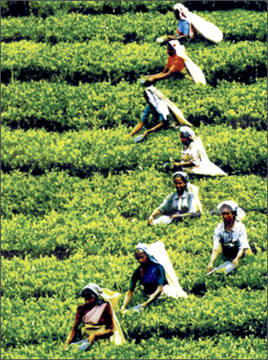|
Business Guest Column
Tea industry survives due to low grown teas
Jayampathy Molligoda
The plantation in- dustry in all its aspects is undoubtedly one of
the most important for Sri Lankan economy since independence.
For more than half a century it has been one of the biggest providers
of employment and export earnings.
Export of Value added teas (Mn Kgs)
Period Total exports Value added Value added
Teas Teas as a % of
total exports
Annual Avg. Annual Avg.
1983-1992 204.8 70.5 34.4%
1993-2003 262.7 94.0 35.8%
|
In view of the diversification of exports from agriculture to
industrial exports during the last two to three decades, the tea sub
sector contributes only 13% of the total export earnings in the year
2005 from the corresponding figure of 42% in the year 1984.
However one can argue that in terms of net foreign exchange earnings,
the tea becomes the number one export earner.
The management of tea estates has undergone several changes during
its 135 year long history of tea plantations in Sri Lanka.
 Prior to 1970ís tea plantations were owned and managed by the private
sector (both foreign and local). Prior to 1970ís tea plantations were owned and managed by the private
sector (both foreign and local).
The sector was nationalised following land reforms in 1972 when land
ownership was restricted to 50 acres. In 1992, the management of
approximately 400 state owned plantations was handed over to twenty-two
private sector companies, and under the second phase of privatisation,
the controlling interest of twenty plantation companies was entrusted
with the private sector.
According to Tea Board statistics for 2006, the annual tea exports
and the total annual production have increased to 315 mn kgs and 310 mn
kgs respectively. In the year 1991 just before the privatization of
state owned plantations, the corresponding figures of exports and annual
production stood at 211 mn kgs and 240 mn. kgs. respectively.
With regard to the tea export data the table shows that share of
value added teas as a percentage of total tea exports have increased by
only 1.4% from 34.4% to 35.8% during the second 10 year period 1993 -
2003 as opposed the first ten year period of 1983 - 1992.
From the above statistics it can be seen that there has been some
positive growth both in the total production as well as total tea
exports during the last 20 year period. However, the growth figures
recorded above are mainly due to the performance shown in the low grown
tea sector by the tea small holders and not necessarily by the
privatised companies.
In the 80ís the low grown production was only 37% of the total
production whereas in the 2000ís the low grown teas have increased up to
57% of the total tea production.
There has been a significant growth in production in the low grown
sector that contributes to the increase in total tea production.
The up/mid country tea production has stagnated during the 20-25 year
period. Not only the production, even the tea prices at the auctions
remained static. In 1990, the auction price in real terms for high grown
teas was US $ 1.70 per kg and 15 years later in 2005 also it was the
same 1/70 US$ per kg.
Hence both in terms of production as well as prices in real terms,
the high/mid grown teasí performance is stagnating.
On the other hand due to exchange gains the auction prices in rupees
may go up but the increases would not sufficient to break-even due to
cost increases.
One of the problems faced by the tea estates in the up country is the
relatively fixed nature of wage costs, which make up approximately 55
per cent of the total COP.
Labour is highly unionised and very influential especially in the
mainstream political system. At present, the daily wage for a tea
plantation worker is around Rs 195/ (excluding daily attendance
incentive).
In real terms, the current daily wage is US $ 1/76 as against US $
1/20 in the year 1990. In short the high grown tea price per kg is even
less than the daily wage rate in real terms thus reversing the trend
over a period of 15 years.
Further, the global over supply of tea would continue to exert a
downward pressure on tea prices. The stagnated tea prices in real terms
coupled with increasing COP would render a significant proportion of the
up country tea estates unprofitable in the near future, especially with
the next round of wage negotiations due in 2008.
In view of the prevailing cost of living hikes, the plantation
companies will be reluctantly compelled to give in to the union demands
for higher wage increases at the future wage negotiations as well.
In view of the above, it has become necessary that a proper national
policy must be formulated for low grown tea and high/ mid tea sub
sectors separately and some winning strategies be crafted for the above
two sub sectors separately in order to achieve desired results. |

